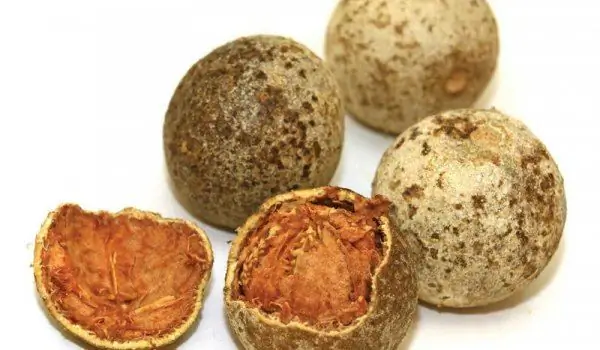2025 Author: Jasmine Walkman | [email protected]. Last modified: 2025-01-23 10:18
Cherimoya is a tree growing at a height of 5-9 m. The flowers are arranged along the branches on short stalks and consist of three fleshy outer petals and three much smaller inner ones.
Cherimoya begins to bear fruit at the age of 4-5 years. But after the age of 6, the tree produces twice as many more fragrant and delicious fruits.
The fruits resemble a heart shape, 10-20 cm long and 10 cm wide. The content is fragrant, white and creamy / fibrous cellulose /, where about twenty shiny black seeds are located. The fruits range from 0.5 to 3 kilograms.
Cherimoya is also known as the "ice cream tree" because of its consistency, resembling frozen ice cream, as well as because of its delicate and sweet taste. We can say that it looks like pineapple, papaya, strawberries, mango, banana and cream combined.
The plant grows in subtropical or mild temperate climates. The tree prefers a dry environment. During the winter months it is stored in rooms with a temperature of 10 to 14 degrees, where it can wait until spring.
The origin of the fruit comes from Ecuador, Colombia, Bolivia and Peru. Currently, cherimoya is also imported from Thailand, Malaysia, China, Australia, Spain, Chile, Venezuela and Colombia.
The origin of the fruit is from ancient times. Its seeds have been found in archeological sites in Peru. The fruits are depicted on ceramics. Wild trees are common in southwestern Ecuador, where the areas are sparsely populated and have large wooded areas.
The flesh of the fruit has a soft creamy structure. Chilled, it looks like a tropical sherbet. In Chile, it is preferred for filling waffle cups for ice cream and pastries or simply added to yogurt.

The inside is consumed with a spoon, after cutting the fruit in half lengthwise. It is added to salads, drinks, desserts. In order not to turn black, sprinkle with lemon slices or orange juice. Attention! Cherimoya seeds are unfit for consumption!
100 g of fresh fruit contain 74 kcal. Not especially recommended for overweight people, as it contains a lot of sugar.
Useful properties of cherimoya
Fruits contain many useful substances: proteins, carbohydrates, folic acid, calcium, phosphorus, iron, thiamine, riboflavin, glucose, fructose, sucrose, cellulose, pepsin, as well as organic acids - citric and succinic. Contains vitamin C, B vitamins.
With its ideal combination of acids and sugars, cherimoya is easily digestible, nutritious and very tasty. The use of these fruits normalizes the acidity of the stomach, improves liver function, stimulates weight loss.
Cherimoya and has application as a medicinal plant. In recent years, substances have been found in the plant that have high antibacterial activity. Stems and leaves are rich in specific alkaloids - liriodenine, annoninom, mihelalbinom and reticulin. Cherimoya leaves and seeds contain a lot of essential oils.
The bark and leaves in South America are used to make soothing and relaxing tea, which improves digestion and has a mild laxative effect. Indians believe that cherimoya leaves prevent the development of tumors. Two spoons of dried fruit are an excellent antidote for food poisoning.
Dangerous properties of cherimoya
Cherimoya contains a large amount of sugar and carbohydrates, so diabetics should eat these fruits with caution.
Those who have decided to try cherimoya for the first time should know that the seeds are poisonous.
Recommended:
Ararut - The Unknown Cereal

More than 10,000 types of cereals are known worldwide. Despite this diversity, humanity uses for its food mainly three types of them - wheat, barley and corn. Lately, as a substitute for them, he is increasingly entering araru . This unknown cereal is a perennial herbaceous plant that until recently was used mainly for commercial purposes, as a food thickener and in the pharmaceutical industry.
Unknown Citrus Fruits: Yuzu

Yuzu is a Japanese citrus fruit the size of a tangerine and quite sour. Yuzu is the most popular of all citrus fruits in Japan. Yuzu became popular in the US culinary scene in the early 2000s and to this day, despite its rare and expensive appearance, this fruit can still be found on restaurant menus in the form of sauces, cocktails and desserts.
Unknown Exotic Fruits: Longan

Longan is an evergreen tree with exotic fruits. The height of the tree reaches twenty meters. Translated, its name means Dragon's Eye. In China it is called Lam Yai. It is grown mainly in China, Thailand, Taiwan, Vietnam and Indonesia. These fruits are said to be some of the sweetest in the world.
Unknown Exotic Fruits: Wooden Apple

In some parts of the world, the interesting fruit, the apple tree, is called the elephant apple because it is a favorite food of elephants, while in other areas it is called the wood apple because of its hard shell. In fact, it is considered sacred by Indians and is widely cultivated and consumed in India.
Cherimoya

Cherimoya is the fruit of the Annona cherimola tree, which belongs to the Annonaceae family. Cherimoya is also known as the golden Peruvian apple. The tree grows in the Andean valley above 1500 meters above sea level. It is found from Peru to Colombia, in Australia, California, Italy, some parts of Spain and many other warm countries around the world.

